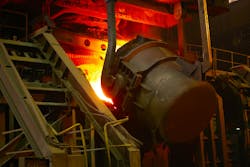5 Reasons Metallurgy is Essential in Material Selection for Harsh Environments
Designing equipment for use in harsh environments is no easy task. Finding the appropriate materials is one of the most crucial but potentially complex steps, so manufacturers must note the importance of metallurgy and materials engineering in this process.
Conventional alloys may not provide the qualities necessary for use in heavy industrial environments. Metallurgy provides a way forward by opening the door to purpose-built materials and custom alloys. While this practice doesn’t often take the spotlight in engineering circles, it’s essential to this process for several reasons.
Resilience
The primary reason material selection for harsh environments is so difficult is the higher need for resilience. Carbon steel—which accounts for roughly 85% of all steel produced—is susceptible to natural rust, making it unfit for high-moisture applications. Other metals have varying melting points, oxidation risks and other shortcomings that limit their usefulness in industrial use cases.
Metallurgy and materials engineering help manufacturers work around these natural limitations. Understanding how different additions can make a metal more corrosion-resistant or give it a higher strength-to-weight ratio is the first step in designing more resilient industrial equipment.
These considerations are even more important when dealing with niche workplace risks like radiation or high pressure. Most widely available alloys can’t withstand these conditions, so manufacturers must turn to metallurgy to achieve the necessary qualities.
Performance
Designing materials to have unique characteristics is about more than just withstanding unusual pressure. It’s also a matter of delivering consistent performance amid these conditions. Harsher working environments typically carry higher costs because of their safety issues, but higher performance standards help offset those expenses.
READ MORE: Production Materials are Critical in Prototyping
It’s easy to think of output quality as a mechanical design issue, but material selection impacts it, too. If the metal in a power tool gets too soft at high temperatures, its force will likely degrade with extensive use. Similarly, even microscopic cracks and imperfections from extreme surroundings can hinder equipment’s precision.
In light of these concerns, metallurgy must consider a product’s end use, not just its operating environment. Surviving amid certain conditions and maintaining a high-quality standard are often two different measures.
Safety
Metallurgy and materials engineering also impact worker safety. Part of that concerns equipment’s ability to hold up under tough conditions. If a component warps or breaks mid-process, it could endanger nearby employees.
Material engineers must also consider hazards from metallurgy itself. Some additives may introduce risks while making the metal more desirable in other areas. Carbon nanomaterials, for example, cause respiratory problems similar to asbestos when inhaled. Manufacturers may create more risks than benefits if they don’t account for these factors.
Other additives can reduce workplace hazards. Nanomaterials that increase materials’ absorbent properties can minimize dangerous fumes in industrial workplaces. Engineers must understand all these positive and negative possibilities to find the ideal solution.
Long-Term Value
Paying more attention to materials’ metallurgical properties is important for long-term equipment value, too. Eventually, as new technologies emerge or facilities expand, businesses may need to swap their machinery. Their tools’ material qualities impact how smoothly that process goes.
While older equipment will always have a lower resale value than new alternatives, every machine depreciates differently and its condition heavily affects its value. More resilient materials make a machine more likely to stay in prime condition longer, earning a higher resale price. A tool may also depreciate less dramatically if it can serve niche roles, such as service in extreme environments.
These concerns may not be at the top of every manufacturer’s mind, but they come into play for every facility eventually. Ensuring a higher resale value down the line is always beneficial.
Cost Efficiency
Similarly, an emphasis on metallurgy and materials engineering can make equipment more cost-efficient. Much of this is a matter of maintenance—more resilient materials will degrade less quickly, reducing repair costs over the equipment’s life span.
Imbuing materials with unique characteristics like natural corrosion resistance or high strength-to-weight ratio improves cost efficiency, too. These qualities mean machines need fewer supporting materials and systems to perform optimally. As a result, they’re less expensive to operate over time.
Metallurgy can sometimes have a more direct impact on cost efficiency. Making some materials lighter, more or less conductive, or less friction-prone ensures components use less electricity to move or conserve more energy. Consequently, end-users can lower their related utility costs.
Metallurgy Best Practices for Harsh Environments
Materials engineers wanting to capitalize fully on these metallurgy benefits should keep several considerations in mind. The first and most important is determining the specific conditions a material must withstand. What temperature ranges can manufacturers expect the equipment to operate in? How much weight must it bear? How much atmospheric pressure must it endure? Do these factors change over time?
Similarly, metallurgy and materials engineering should consider the specific use case. An industrial drill and a boiler may operate in similar environments, but the drill must put up with much more physical pressure. These parameters complement environmental factors to reveal the properties most important for each material.
READ MORE: Enclosure Materials Available for Rough Environments
Engineers must also consider budget restraints. Metallurgy can quickly become expensive, especially when introducing novel additives like nanomaterials. These advanced options may yield better results, but those relative advantages shrink at prohibitive price points. It’s also worth considering how much metal prices can shift—iron ore prices rose by 116% between 2020 and 2021, almost entirely due to demand volatility.
Of course, harsh environments often warrant a higher price tag. As long as the material selection provides a noticeable monetary difference in its long-term application, higher production costs may be manageable.
Metallurgy and Materials Engineering are Inseparable
Any manufacturer producing equipment for use in harsh environments must consider how metallurgy and materials engineering impact their products’ end use. Similarly, companies buying this machinery should understand how different materials affect their utility.
Natural raw materials don’t have the characteristics necessary to support high-stress industrial workloads. Consequently, materials engineers cannot overlook metallurgy as an essential part of the design and manufacturing process. While material qualities aren’t the only influencing factor, they are one of the most foundational, so they deserve attention.
About the Author

Emily Newton
Emily Newton is a technology and industrial journalist. She is also the editor in chief of Revolutionized. She has over five years covering stories about warehousing, logistics and distribution.
